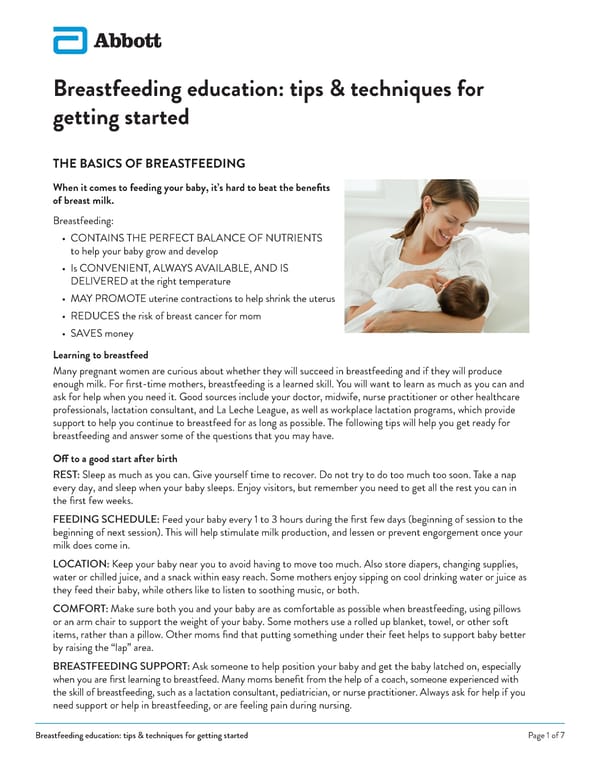Breastfeeding education: tips & techniques for getting started
Many pregnant women are curious about whether they will succeed in breastfeeding and if they will produce enough milk.
Breastfeeding education: tips & techniques for getting started THE BASICS OF BREASTFEEDING When it comes to feeding your baby, it’s hard to beat the benefits of breast milk. Breastfeeding: • CONTAINS THE PERFECT BALANCE OF NUTRIENTS to help your baby grow and develop • Is CONVENIENT, ALWAYS AVAILABLE, AND IS DELIVERED at the right temperature • MAY PROMOTE uterine contractions to help shrink the uterus • REDUCES the risk of breast cancer for mom • SAVES money Learning to breastfeed Many pregnant women are curious about whether they will succeed in breastfeeding and if they will produce enough milk. For first-time mothers, breastfeeding is a learned skill. You will want to learn as much as you can and ask for help when you need it. Good sources include your doctor, midwife, nurse practitioner or other healthcare professionals, lactation consultant, and La Leche League, as well as workplace lactation programs, which provide support to help you continue to breastfeed for as long as possible. The following tips will help you get ready for breastfeeding and answer some of the questions that you may have. Off to a good start after birth REST: Sleep as much as you can. Give yourself time to recover. Do not try to do too much too soon. Take a nap every day, and sleep when your baby sleeps. Enjoy visitors, but remember you need to get all the rest you can in the first few weeks. FEEDING SCHEDULE: Feed your baby every 1 to 3 hours during the first few days (beginning of session to the beginning of next session). This will help stimulate milk production, and lessen or prevent engorgement once your milk does come in. LOCATION: Keep your baby near you to avoid having to move too much. Also store diapers, changing supplies, water or chilled juice, and a snack within easy reach. Some mothers enjoy sipping on cool drinking water or juice as they feed their baby, while others like to listen to soothing music, or both. COMFORT: Make sure both you and your baby are as comfortable as possible when breastfeeding, using pillows or an arm chair to support the weight of your baby. Some mothers use a rolled up blanket, towel, or other soft items, rather than a pillow. Other moms find that putting something under their feet helps to support baby better by raising the “lap” area. BREASTFEEDING SUPPORT: Ask someone to help position your baby and get the baby latched on, especially when you are first learning to breastfeed. Many moms benefit from the help of a coach, someone experienced with the skill of breastfeeding, such as a lactation consultant, pediatrician, or nurse practitioner. Always ask for help if you need support or help in breastfeeding, or are feeling pain during nursing. Breastfeeding education: tips & techniques for getting started Page 1 of 7
 Breastfeeding education: tips & techniques for getting started Page 2
Breastfeeding education: tips & techniques for getting started Page 2